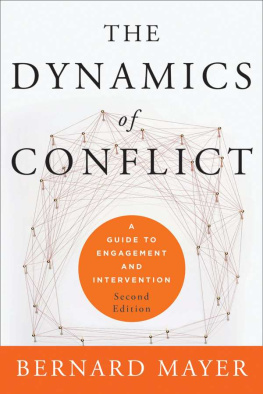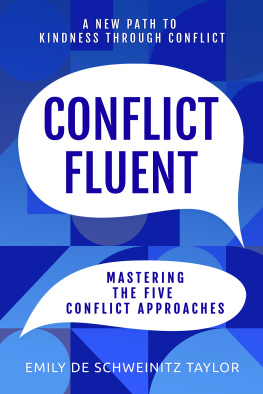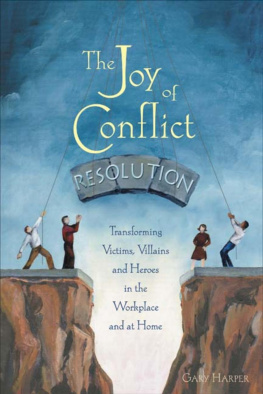Contents
Praise for the First Edition
Drawing on his wide-ranging experience as one of the founders and leaders of our field, Mayer has given us a brilliant mosaic of conflict, its management, and resolution. This book is must reading for anyone who thinks deeply about the nature and origins of conflict and believes that a deeper appreciation for its complexity will enable us to transform our culture.
Daniel Bowling, executive director, Society of Professionals in Dispute Resolution
Bernie Mayer is a natural teacher. His conceptual framework of conflict and resolution will challenge the most experienced professional to evaluate their own understandings. This is a must-read for both beginning and experienced professionals.
Arnold Shienvold, president, Academy of Family Mediators
This is a great book. Mayer has delivered our field a gifta reflective practitioners handbook, complete with theoretical understandings and practical suggestions. Rooted in his marvelous intuition, shaped and authenticated from years of experience, and presented in a straightforward style true to his mediator and educator vocations, The Dynamics of Conflict Resolution should be on every conflict resolvers and trainers bookshelf.
John Paul Lederach, author, Journey to Reconciliation and Preparing for Peace
This book is high on my required reading list! An outstanding contribution to the literature in the field.
Katherine Hale, professor and chair, Conflict Resolution Program, Antioch University
As an additional resource for this edition, suggested further readings on topics relevant to each chapter can be found at www.wiley.com/college/mayer . A sample syllabus based on the material in this book and an accompanying PowerPoint presentation are also posted there.

Copyright 2012 by John Wiley & Sons, Inc. All rights reserved.
Published by Jossey-Bass
A Wiley Imprint
One Montgomery Street, Suite 1200, San Francisco, CA 94104-4594 www.josseybass.com
No part of this publication may be reproduced, stored in a retrieval system, or transmitted in any form or by any means, electronic, mechanical, photocopying, recording, scanning, or otherwise, except as permitted under Section 107 or 108 of the 1976 United States Copyright Act, without either the prior written permission of the publisher, or authorization through payment of the appropriate per-copy fee to the Copyright Clearance Center, Inc., 222 Rosewood Drive, Danvers, MA 01923, 978-750-8400, fax 978-646-8600, or on the Web at www.copyright.com . Requests to the publisher for permission should be addressed to the Permissions Department, John Wiley & Sons, Inc., 111 River Street, Hoboken, NJ 07030, 201-748-6011, fax 201-748-6008, or online at www.wiley.com/go/permissions .
Limit of Liability/Disclaimer of Warranty: While the publisher and author have used their best efforts in preparing this book, they make no representations or warranties with respect to the accuracy or completeness of the contents of this book and specifically disclaim any implied warranties of merchantability or fitness for a particular purpose. No warranty may be created or extended by sales representatives or written sales materials. The advice and strategies contained herein may not be suitable for your situation. You should consult with a professional where appropriate. Neither the publisher nor author shall be liable for any loss of profit or any other commercial damages, including but not limited to special, incidental, consequential, or other damages. Readers should be aware that Internet Web sites offered as citations and/or sources for further information may have changed or disappeared between the time this was written and when it is read.
Jossey-Bass books and products are available through most bookstores. To contact Jossey-Bass directly call our Customer Care Department within the U.S. at 800-956-7739, outside the U.S. at 317-572-3986, or fax 317-572-4002.
Wiley also publishes its books in a variety of electronic formats and by print-on-demand. Some material included with standard print versions of this book may not be included in e-books or in print-on-demand. If the version of this book that you purchased references media such as CD or DVD that was not included in your purchase, you may download this material at http://booksupport.wiley.com . For more information about Wiley products, visit www.wiley.com .
Library of Congress Cataloging-in-Publication Data
Mayer, Bernard S.
The dynamics of conflict : a guide to engagement and intervention/Bernard Mayer.2nd ed.
p. cm.
Includes bibliographical references and index.
ISBN 978-0-470-61353-5 (cloth); ISBN 978-1-118-17822-5 (ebk); ISBN 978-1-118-17823-2 (ebk); ISBN 978-1-118-17824-9 (ebk)
1. Conflict (Psychology) 2. Conflict management. 3. Negotiation. 4. Problem solving. I. Title.
BF637.I48M39 2012
303.69dc23 2011044985
In memory of Fritz and Carola Mayer For their courage, love, and example
Preface to the Second Edition
A Reflective Approach to Conflict
There is nothing so practical as a good theory.
Lewin, 1952, p. 169
Conflict intervention is a skill, a vocation, a profession, and a cause. We are all conflict participants and conflict interveners. We bring to this endeavor the totality of who we areour life experience, our values, our natural talents and limitations, our personality, our training, and our professional background. How we handle conflict is central to how we handle life, whether or not we are conflict specialists, and so developing our capacity to deal with conflict is a lifelong challenge. As we seek to become more adept in conflict, we tend to focus on the central skills that conflict calls forthfor example, we want to increase our capacity to communicate, to negotiate, to use our power effectively, to respond to others use of power, and to facilitate interactions among others. Its tempting to see these skills as residing in a series of techniques, a particular process, or a set of steps or stages. These are easy to learn, tangible, and often useful. But what makes us effective in how we engage in conflict is not a set of processes, methodologies, or tactics; it is a way of thinking, a set of values, an array of analytical and interpersonal skills, and a clear focus.
When I wrote the first edition of this book over ten years ago, I was convinced that being effective conflict specialists required us to develop practical ways of thinking about conflict and conflict intervention. I believed that it was essential for us to identify and embrace those concepts that help us make sense of our experience, that connect our efforts to the lessons learned by other practitioners and researchers, and that help us find that elusive but critical connection between theory and practice. I had come to this conviction through my own experience as a mediator and teacher, primarily through my work with CDR Associates of Boulder, Colorado. As a practitioner, I knew that when I was in the middle of dealing with a conflict what I most needed was a set of clear and practical ideas about how to make sense of what was going on and what my intervention choices might be. As a teacher, I often noticed an interesting change that trainees experienced during the course of a class or workshop. Participants came eager to be taught how to do thingshow to open a mediation, reframe a toxic comment, deal with a resistant party, or nail down an agreement. But by the end of the training what seemed to have had the biggest impact was their exposure to new ways of thinking about mediation, negotiation, conflict, and communication. When they came away with a set of ideas and perceptions that could guide their practice and help them integrate new skills and techniques into their approach to conflict, something significant had happened.
Next page






